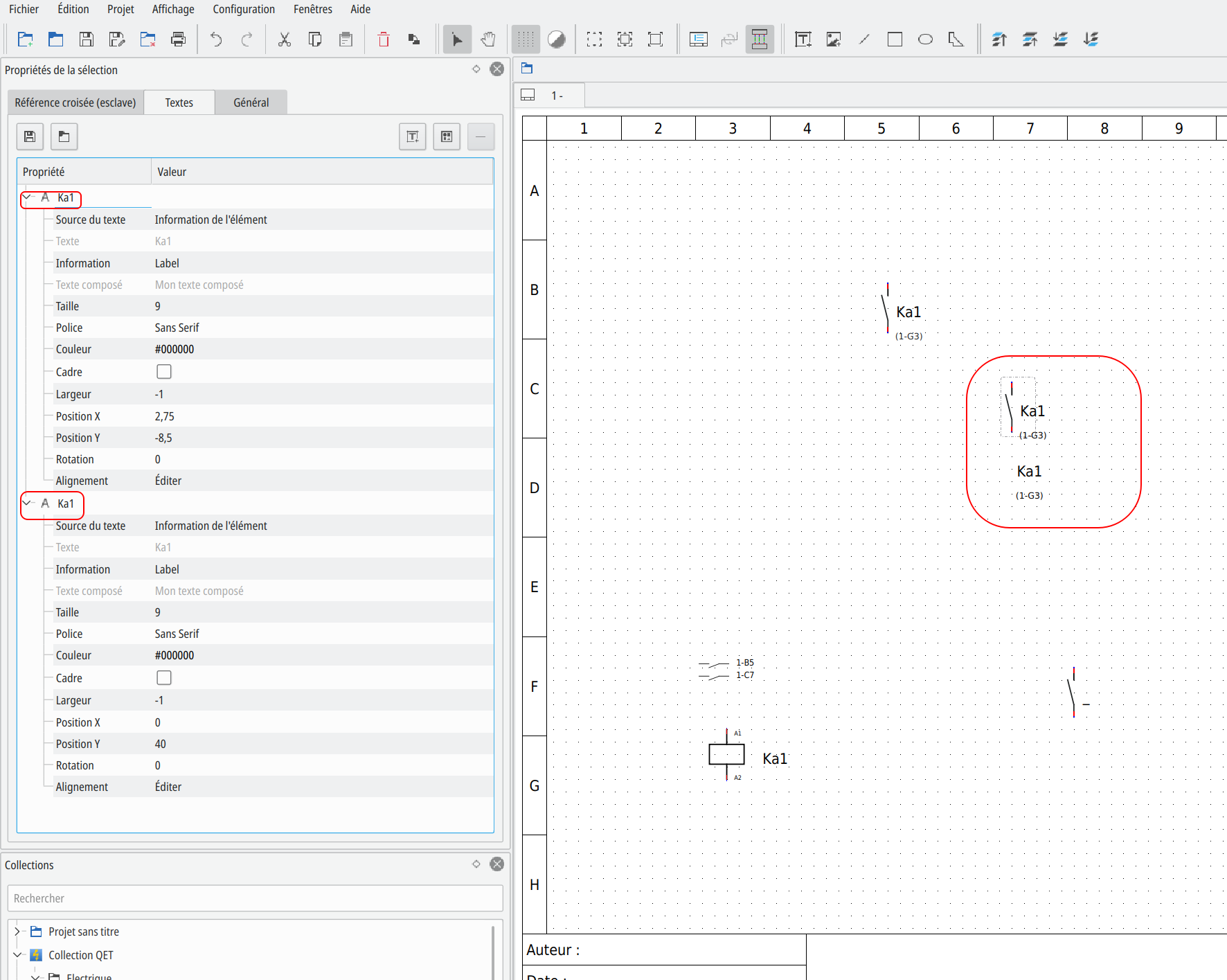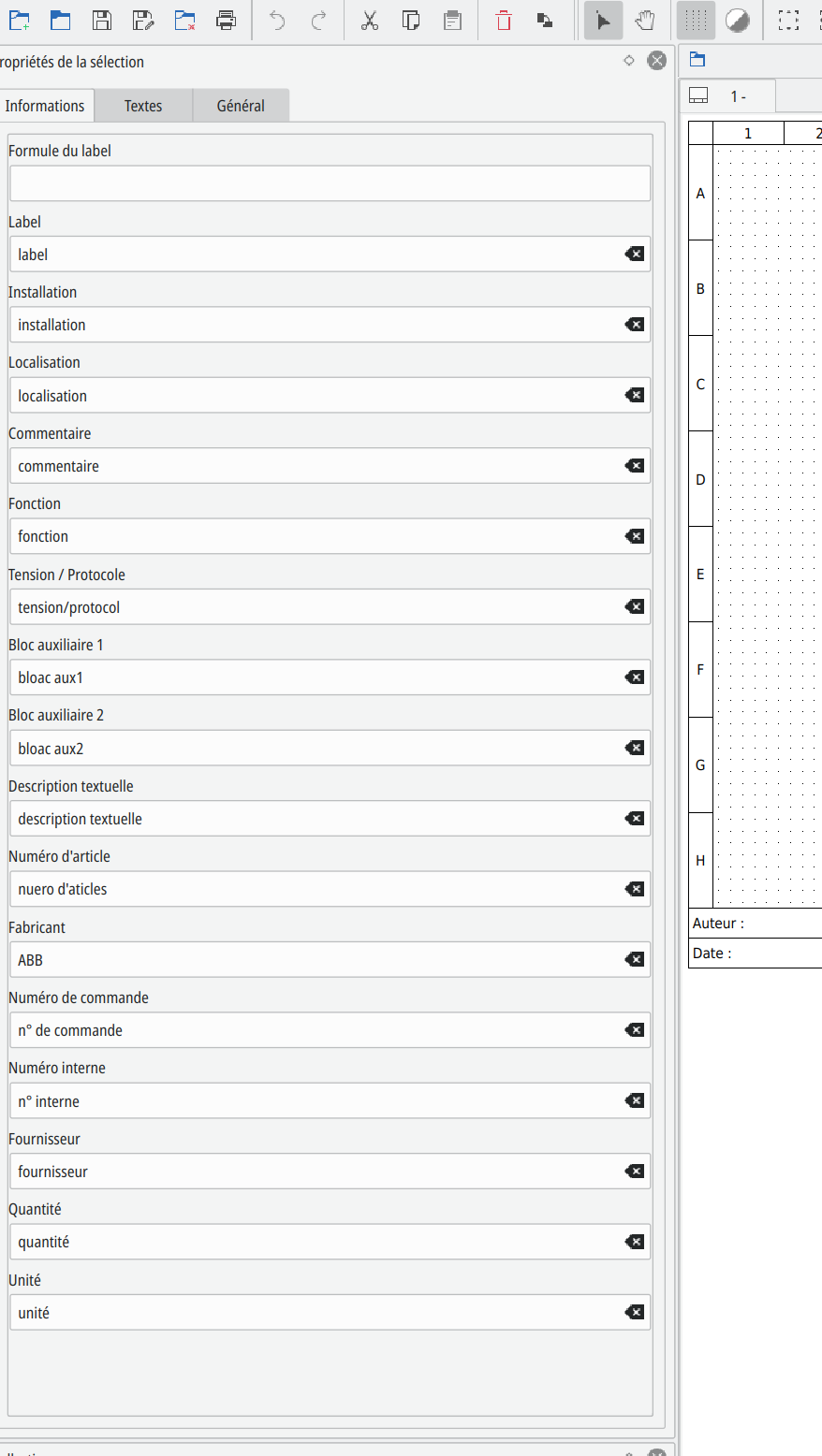Le but caché serait pas dans les cas des vannes par exemple d'avoir plusieurs XREfs, PLC-> puis actionneur électrique, puis pneumatique, etc?
3,376 2020-04-10 21:57:12
Re: Problème texte dynamique et texte composé de label (34 replies, posted in FR : Aide, suggestions, discussions, ...)
3,377 2020-04-10 11:48:55
Re: Extraire liste label (8 replies, posted in FR : Aide, suggestions, discussions, ...)
On pourrait rajouter ce qui ce fait pour la nomenclature dans la branche devel, afin que l'user puisse graphique faire ses requêtes =, IS NOT NUll, etc dans l'export CSV.
https://git.tuxfamily.org/qet/qet.git/c … cae8769015
+ auto f = FilterFor(key);
+ switch (f.first)
+ {
+ case 0: //No filter
+ break;
+ case 1: //Not empty
+ filter_ += QString(" AND ") += key += " IS NOT NULL";
+ break;
+ case 2: //empty
+ filter_ += QString(" AND ") += key += " IS NULL";
+ break;
+ case 3: // contain
+ filter_ += QString(" AND ") += key += QString(" LIKE'%") += f.second += "%'";
+ break;
+ case 4: // not contain
+ filter_ += QString(" AND ") += key += QString(" NOT LIKE'%") += f.second += "%'";
+ break;
+ case 5: // is equal
+ filter_ += QString(" AND ") += key += QString("='") += f.second += "'";
+ break;
+ case 6: // is not equal
+ filter_ += QString(" AND ") += key += QString("!='") += f.second += "'";
+ break;
3,378 2020-04-10 11:43:18
Re: Problème texte dynamique et texte composé de label (34 replies, posted in FR : Aide, suggestions, discussions, ...)
L'astuce ou workaround consiste une fois tes textes ajoutées sur les esclaves déjà liés de redéfinir le label du maître et de remettre ta formule.
3,379 2020-04-10 10:59:52
Re: Problème texte dynamique et texte composé de label (34 replies, posted in FR : Aide, suggestions, discussions, ...)
Si j'entre KA1 dans label ça fonctionne et tu as accès sur le nouveau texte dynamique au label, pas si j'entre %KA1 dans la formule du label.
Entrer une valeur "%" quelque soit le champ, ou entrer le label dans le champ de formule empêche de choisir sur un second texte dynamique le choix du label du maître.
3,380 2020-04-09 18:58:34
Re: Problème texte dynamique et texte composé de label (34 replies, posted in FR : Aide, suggestions, discussions, ...)
Hum, si tu re essayes par la suite sur ce nouveau texte dynamique ça fonctionne..
3,381 2020-04-09 18:09:19
Re: Datentransfer (4 replies, posted in DE : Hilfe, Vorschläge, Unterhaltungen...)
Hello Orwo,
on the second computer, run qelectrotech in a shell or terminal and after try in the QET program to open your project located in your USB key, paste the message from the terminal here to understand what your problem is.
3,382 2020-04-09 17:56:35
Re: Problème texte dynamique et texte composé de label (34 replies, posted in FR : Aide, suggestions, discussions, ...)
Merci Alexis pour la vidéo, je vais la transférer à Joshua, et aller me reposer un peu....j'ai du mal à conserver les yeux ouverts..
De nouveaux paquets sont encours de builds et d'upload.
3,383 2020-04-09 17:42:06
Re: Problème texte dynamique et texte composé de label (34 replies, posted in FR : Aide, suggestions, discussions, ...)
Si, sur mon esclave déja relié, je rajoute un nouveau texte dynamique "information de l’élément" puis "label", il prend bien le label du maître ainsi que la XREF du maître déjà relié .. et je me retrouve bien avec deux fois la même chose..
3,384 2020-04-09 17:02:18
Re: Problème texte dynamique et texte composé de label (34 replies, posted in FR : Aide, suggestions, discussions, ...)
scorpio810 wrote:Sous linuxmint les paquets ne devraient pas tarder à arriver, le temps que les builder PPA de Ubuntu compilent les différentes versions.
Par contre les deb, Windows, macOS, AppImages et Flatpak, c'est déjà envoyé.
Il n'y a que les Snap et le paquets du PPA qui ne sont pas compilés par ma workstation, ça va très vite maintenant avec le Threadripper ^^.Sous linuxmint, je suis à jour....
Je vais attendre un peu pour faire de nouveaux build de paquets, Joshua corrige des bugs à la pelle aujourd'hui ^^.![]()
- Log -----------------------------------------------------------------
commit 5c6f556ad3b21ff827d3a11fb1eb383858ca7e59
Author: Claveau Joshua <Joshua@>
Date: Thu Apr 9 16:58:05 2020 +0200
Minor revamp
Remove unused include.
QETproject : Default titleblock are set in the default constructor
instead of set by qetdiagrameditor.
conductor, border, report and xref propertie are now set in the header
of QETProject instead of set by the qetdiagrameditor just after the
creation of a new project.
3,385 2020-04-09 16:47:46
Re: Nouveautés de la version de développement 0.8 (317 replies, posted in News)
3,386 2020-04-09 16:45:56
Re: Problème texte dynamique et texte composé de label (34 replies, posted in FR : Aide, suggestions, discussions, ...)
Alexis, tu peux envoyer un bout de schéma reproduisant ton soucis?
3,387 2020-04-09 16:39:57
Re: Datentransfer (4 replies, posted in DE : Hilfe, Vorschläge, Unterhaltungen...)
Good day,
I have stored a qet file on a memory stick in order to open it again on another computer and continue to edit it.
The file cannot be opened directly from the stick with version 7. If the file is on the desktop, it can be opened. The file then does not contain the user collection. Editing on the second computer is then not possible.
UBUNTU 18.04 runs on both computers.Are there any version problems?
Where can I find the release note on the respective computers within the program?
I would be happy to receive an answer.
Yours sincerely
Guten Tag,
I think you have a problem in your Ubuntu, off course you can open project file on memory sticky without problem.
Where are you found this QET package, in ùy repository or Ubuntu official deb package?
The User collection is stored in your ~/.qet/elements/ folder, you need to copy this directory to your memory stick and choose In QET settings the right PAH for Custom collection and reload collection by right click on elements panel to have these elements for drag and drop in yours projects.
I hope that can help you?
Laurent
3,388 2020-04-09 16:31:13
Re: Problème texte dynamique et texte composé de label (34 replies, posted in FR : Aide, suggestions, discussions, ...)
- Log -----------------------------------------------------------------
commit 017f78fb13a17f0dcf37e54b594190b7312997ac
Author: Claveau Joshua <Joshua@>
Date: Thu Apr 9 16:12:21 2020 +0200
Fix crash when close project
At time of closing project, if a master element(may be every linkable
element) is selected and the editor dock display a lot of available
slave, qet crash.
3,389 2020-04-09 16:07:50
Re: Problème texte dynamique et texte composé de label (34 replies, posted in FR : Aide, suggestions, discussions, ...)
Exemple je pose une bobine "maître" KA1, je pose ensuite 4 contact NO "esclave" je les relies tous à ma bobine maître, tous mes contacts ont le label KA1.
3,390 2020-04-09 15:55:29
Re: Problème texte dynamique et texte composé de label (34 replies, posted in FR : Aide, suggestions, discussions, ...)
Sous linuxmint les paquets ne devraient pas tarder à arriver, le temps que les builder PPA de Ubuntu compilent les différentes versions.
Par contre les deb, Windows, macOS, AppImages et Flatpak, c'est déjà envoyé.
Il n'y a que les Snap et le paquets du PPA qui ne sont pas compilés par ma workstation, ça va très vite maintenant avec le Threadripper ^^. ![]()
3,391 2020-04-09 15:33:07
Re: Problème texte dynamique et texte composé de label (34 replies, posted in FR : Aide, suggestions, discussions, ...)
La derniere version en paquet c'est la 6179.
3,392 2020-04-09 15:23:35
Re: Problème texte dynamique et texte composé de label (34 replies, posted in FR : Aide, suggestions, discussions, ...)
Salut,
bon tu as le don d'expliquer quelque chose de simple en le rendant compliqué à lire, ou c'est mon cerveau qui fatigue à cette heure, j'aurais dut peut-être du aller faire une 'tit sieste cet après-midi..., vi je suis debout depuis 3h du mat. :p
Déjà pour moi le voyant est l'esclave du contact du bouton poussoir, ce contact active une entrée automate, et suivant ta programmation et l’état du poussoir une sortie automate alimente ton voyant ou pas.
Reprend moi, si je suis passé à coté de la plaque ![]() et je m'excuse d'avance si j'ai mal compris ta question.
et je m'excuse d'avance si j'ai mal compris ta question. ![]()
T'as essayé avec la dernière fournée de paquets que je viens juste d'envoyer?
- Log -----------------------------------------------------------------
commit 94aa5c024734352ee62402450d48af18fba8ae90
Author: Claveau Joshua <Joshua@>
Date: Wed Apr 8 19:27:24 2020 +0200
Minor fix : in some condition master cross Xref are not displayed
3,393 2020-04-09 13:45:18
Re: Financement nouvelle machine de build (23 replies, posted in News)
Thanks Joan. ![]()
3,394 2020-04-08 20:44:56
Re: Nouveautés de la version de développement 0.8 (317 replies, posted in News)
3,395 2020-04-08 14:16:15
Re: Nouveautés de la version de développement 0.8 (317 replies, posted in News)
merci, j'ai corrigé cette typo. ![]()
3,396 2020-04-06 18:13:20
Re: Menu éditeur (7 replies, posted in FR : Aide, suggestions, discussions, ...)
J'avoue que je ne comprend pas très bien ton besoin.

<elementInformations>
<elementInformation name="plant" show="1">installation</elementInformation>
<elementInformation name="tension-protocol" show="1">tension/protocol</elementInformation>
<elementInformation name="manufacturer" show="1">ABB</elementInformation>
<elementInformation name="quantity" show="1">quantité</elementInformation>
<elementInformation name="unity" show="1">unité</elementInformation>
<elementInformation name="auxiliary2" show="1">bloac aux2</elementInformation>
<elementInformation name="machine-manufacturer-reference" show="1">n° interne</elementInformation>
<elementInformation name="function" show="1">fonction</elementInformation>
<elementInformation name="auxiliary1" show="1">bloac aux1</elementInformation>
<elementInformation name="manufacturer-reference" show="1">n° de commande</elementInformation>
<elementInformation name="description" show="1">description textuelle</elementInformation>
<elementInformation name="supplier" show="1">fournisseur</elementInformation>
<elementInformation name="label" show="1">label</elementInformation>
<elementInformation name="location" show="1">localisation</elementInformation>
<elementInformation name="designation" show="1">nuero d'aticles</elementInformation>
<elementInformation name="comment" show="1">commentaire</elementInformation>
</elementInformations>
3,397 2020-04-06 17:59:52
Re: Nouveautés de la version de développement 0.8 (317 replies, posted in News)
Filtres :
SELECT ei.label, ei.plant, ei.location, ei.comment, ei.FUNCTION, ei.tension_protocol, ei.auxiliary1, ei.auxiliary2, ei.description, ei.designation, ei.manufacturer, ei.manufacturer_reference, ei.machine_manufacturer_reference, ei.supplier, ei.quantity, ei.unity, e.pos, di.title, di.folio, d.pos FROM element_info ei, element e, diagram d, diagram_info di WHERE ei.element_uuid = e.uuid AND di.diagram_uuid = d.uuid AND e.diagram_uuid = d.uuid AND ei.label IS NOT NULL AND ei.comment LIKE'%interface%' ORDER BY ei.label, ei.plant, ei.location, ei.comment, ei.FUNCTION, ei.tension_protocol, ei.auxiliary1, ei.auxiliary2, ei.description, ei.designation, ei.manufacturer, ei.manufacturer_reference, ei.machine_manufacturer_reference, ei.supplier, ei.quantity, ei.unity, e.pos, di.title, di.folio, d.pos
3,398 2020-04-06 16:32:24
Re: Menu éditeur (7 replies, posted in FR : Aide, suggestions, discussions, ...)
Malheureusement c'est en dur dans le code, a moins d’éditer et de recompiler le programme tu ne pourras pas changer de nom ce champ.
3,399 2020-04-06 16:25:54
Re: Project display deteriorated (11 replies, posted in EN : Help, suggestions, discussions, ...)
Same things on new Qt 5.14.2...![]() and always on windows platform..
and always on windows platform..
3,400 2020-04-06 16:02:16
Re: Menu éditeur (7 replies, posted in FR : Aide, suggestions, discussions, ...)
Bonjour Robert,
dans ce même widget, tu vas sur l'onglet textes, là tu changes l’affectation de ton texte sur le type Référence Fabricant.
